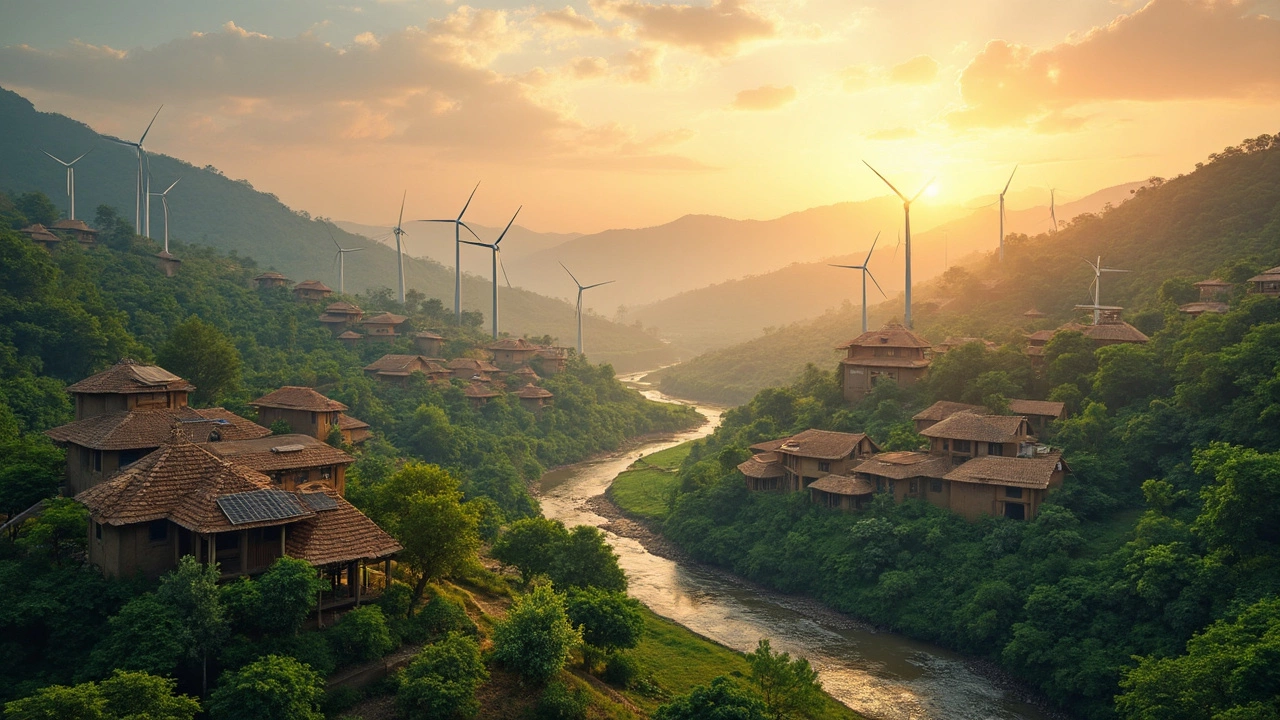When it comes to building an eco-friendly house, picking the right spot is half the battle. You might wonder what makes a location ideal for such a project. Well, it all boils down to finding a balance between nature's offerings and human convenience.
Let's start with climate. If you're dreaming of leveraging solar power, sunny places are your best bet—think places like Arizona or Southern California. They offer loads of sunshine, but make sure to consider cooling solutions, as these areas can get pretty hot.
Another essential factor is resource availability. Consider places with easy access to sustainable materials, like regions where reclaimed wood or locally sourced stone is common. This not only reduces transportation impact but also supports the local economy.
- Climate Considerations
- Resource Availability
- Community and Legislation
- Proximity to Nature
- Renewable Energy Potential
- Local Infrastructure and Services
Climate Considerations
Picking the right climate for your eco-friendly house is a game-changer. Why? Because it influences everything from the materials you'll use to the energy systems you'll put in place. Think of climate as your house's lifetime partner—get it right, and everything else falls into place.
If harnessing solar power is high on your list, sunnier locations are your friends. Regions like the Southwestern U.S. boast over 250 sunny days a year, but they also come with the challenge of higher cooling costs. And what about rain? Places like the Pacific Northwest might not be as sunny, but they're perfect for rainwater harvesting systems. How cool is that?
Interestingly, areas with consistent wind patterns can be ideal for wind energy. Believe it or not, Iowa gets about 42% of its electricity from wind power, making it a solid precedent for individuals looking to incorporate wind solutions at home.
Humidity levels can't be overlooked, either. They play a significant role in heating and cooling demands. Coastal areas with high humidity might require more ventilation, whereas dry regions might need special insulation to maintain comfort.
- Sunny regions: Arizona, Southern California for solar power
- Wind power: Midwest, like Iowa
- Rainwater harvesting: Pacific Northwest
- Low heating costs: Coastal areas with moderate temperatures
Your first step? Weigh your priorities. Is it going to be solar panels, wind turbines, or a lush water harvesting setup? Whatever the case, understanding the climate will steer you in the right direction for truly sustainable living.
Resource Availability
When planning to build a eco-friendly house, one of the smartest moves is to settle in areas where sustainable materials are right at your doorstep. Not only does this trim down the carbon footprint by minimizing transport emissions, but it also supports the local economy.
Consider areas with a wealth of natural resources like forests or quarries that offer locally sourced timber and stone. For instance, the Pacific Northwest is a gold mine for sustainable lumber, thanks to its vast woodlands teeming with responsibly managed forests. On the other hand, if you fancy building with stone, the New England regions are famous for their rich granite reserves.
"The greener the material, the lower the environmental baggage on the build," says Joanna Yarrow, a renowned sustainability expert. "Choosing materials native to your build site can halve your building’s lifetime carbon emissions."
Besides doing a favor to Mother Earth, picking local materials often means quicker access and cheaper costs. Imagine tossing in some reclaimed or recycled materials like bricks, which are both trendy and budget-friendly.
Don't forget to check out zoning regulations and incentives in your chosen area. Some communities offer tax breaks or incentives for using environmentally friendly materials.
- Local Markets: Make friends with local suppliers and markets for sustainable materials.
- Recycling Centers: Find out about the nearest recycling centers for recycled construction materials.
- Community Support: Tap into community-led initiatives and workshops on sustainable building trends.
Resource availability is all about being smart, local, and sustainable. It's a win-win for both your budget and the planet!
Community and Legislation
Picking the right community can make a big difference when building an eco-friendly house. Not all places are equally welcoming to green projects. Finding a community that supports sustainability can make your journey much smoother—and often more enjoyable.
You might want to start by checking local ordinances and building codes. Some areas have restrictions that could limit your eco-friendly ambitions. Others might offer incentives like tax breaks or grants for sustainable building. Oregon, for instance, provides several incentives for renewable energy installations, making it an attractive option for green builders.
Teamwork with neighbors and community groups can also be a boost. Cities like Boulder, Colorado are known for their active green communities. They not only support individual efforts but also have communal projects going on. According to the U.S. Green Building Council, “Communities that prioritize sustainable growth pave the way for a better quality of life for all their residents.”
Amy Mehta, a green urban planning expert, once said, "A supportive community can amplify the impact of your eco-friendly house, making green living a collective effort."
So how do you find such a place? Here are a few key steps:
- Look for locations known for green initiatives—think Portland or Austin.
- Research local government websites for information on environmental policies.
- Join online forums or local groups focused on sustainability to get insider tips.
- Visit the area and talk to residents about their experiences and community support.
Bottom line: A community that's already leaning green not only cushions your efforts but often enhances them, making it easier to achieve your sustainable living goals.

Proximity to Nature
Building near nature has its perks. Imagine your eco-friendly house right by a forest or a stream. Sounds dreamy, right? Well, it's not just about the vibe. Being close to nature can really amp up the green factor of your home.
First up, building near natural features can help with energy efficiency. Trees can act like natural air conditioners, providing shade in the summer and windbreaks in the winter. This could lower heating and cooling costs, and who doesn't want a smaller energy bill?
Then there's water conservation. If there's a river or lake nearby, it's easier to implement rainwater harvesting or grey water systems. Just be sure to consider any local restrictions about water use.
Living close to nature often means more access to outdoor activities like hiking or biking. It promotes a healthier lifestyle while reducing your carbon footprint. Plus, spending time outdoors is a great way to relieve stress.
However, there are a few things to keep in mind. You want to make sure your home isn't disturbing local wildlife. Consider eco-friendly building methods and materials that won't harm the environment. Also, check if your area is prone to natural disasters like wildfires or floods, and plan accordingly.
In short, being near nature can boost your home's eco-cred. Just be mindful of the environment and local regulations, and you'll have a green haven to be proud of!
Renewable Energy Potential
Picking a location with great renewable energy potential can seriously boost how eco-friendly your house could be. It's not just about grabbing sunshine; there are other nifty options out there to power your home sustainably.
Start by looking at wind power. Some spots, especially coastal areas and open plains, can generate loads of energy with wind turbines. Imagine living in a place like the Midwest, where a single wind farm can power thousands of homes annually.
"Investing in local renewable energy can help communities save money and create jobs," says Dr. Lisa Thompson, an expert from the Green Energy Initiative.
Geothermal energy is pretty cool, too. It's perfect for areas with underground heat sources, like parts of the Pacific Northwest. This method taps into the earth’s natural warmth to efficiently heat your home.
If water is your thing, then hydroelectric might be up your alley. It's common in areas near rivers and is yet another way to harness the earth's resources. However, it's crucial to consider environmental impacts and local regulations.
Let's break down some potential areas and their primary energy sources:
| Region | Common Renewable Source |
|---|---|
| Southwest US | Solar |
| Pacific Northwest | Geothermal |
| Great Plains | Wind |
| Appalachian Region | Hydroelectric |
By considering these energy sources, you're not only setting your eco-friendly house up for success but also supporting cleaner energy for your entire community.
Local Infrastructure and Services
When planning to build an eco-friendly house, don't overlook the importance of local infrastructure and services. You want to ensure your dream home isn't just sustainable but also comfortably livable. So, what's the skinny on this subject?
First off, look into the availability of public transportation. An excellent public transport system can reduce your reliance on cars, which is a huge win for reducing your carbon footprint. Consider areas with robust train or bus networks. For instance, Portland, Oregon, and San Francisco, California, have some of the best systems in the U.S.
Then there's the question of utilities. Make sure your location supports alternative energy solutions, such as solar or wind power. This means checking if local regulations allow for the installation of solar panels or wind turbines and whether there are incentives or rebates available. States like California and Colorado often offer attractive incentives to promote green energy practices.
Access to markets is another critical factor. Fresh, locally-sourced food is a massive part of sustainable living. Check if there are farmers' markets or co-ops nearby, offering organic produce and products. Having these options at your doorstep can significantly enhance your eco-friendly lifestyle.
Healthcare and education are just as crucial, even if they don't sound like they tie directly into eco-friendliness. Quality schools that teach sustainability and access to eco-conscious healthcare facilities support a green lifestyle and foster a community that values sustainable living.
Here's a quick look at what to prioritize:
- Robust public transport options
- Support for sustainable energy utilities
- Access to farmers’ markets or organic co-ops
- Eco-conscious education and healthcare facilities
In a nutshell, the perfect spot for your sustainable home is not just where the sun shines the brightest but also where infrastructure and services align with a sustainable lifestyle. Thinking ahead on these aspects ensures that your eco-friendly house fits seamlessly into your life, offering comfort and sustainability in equal measures.
